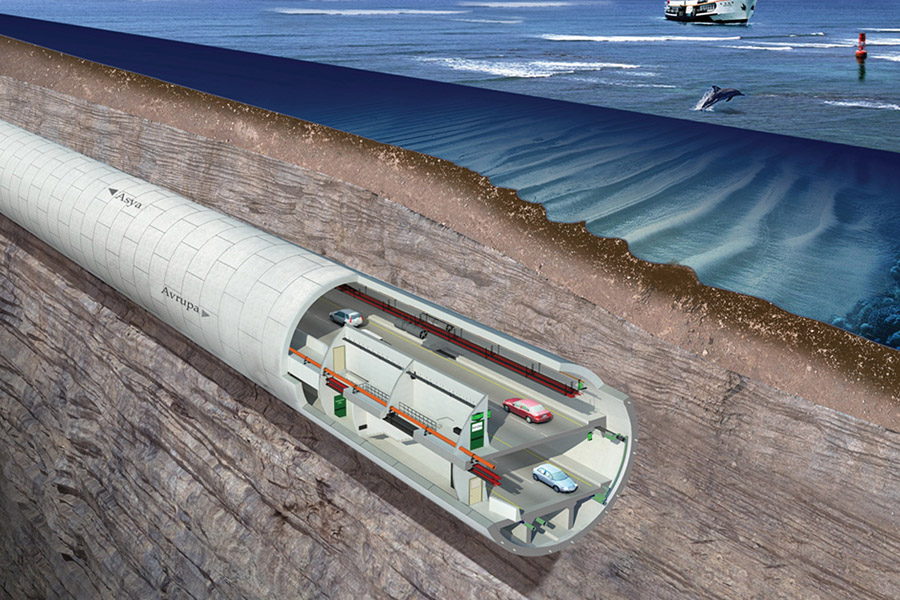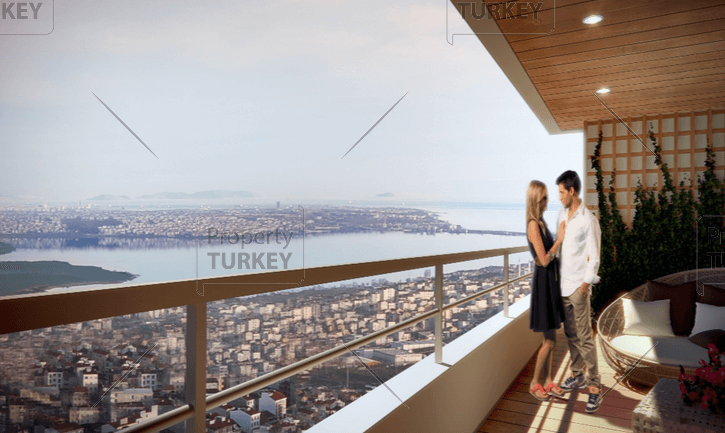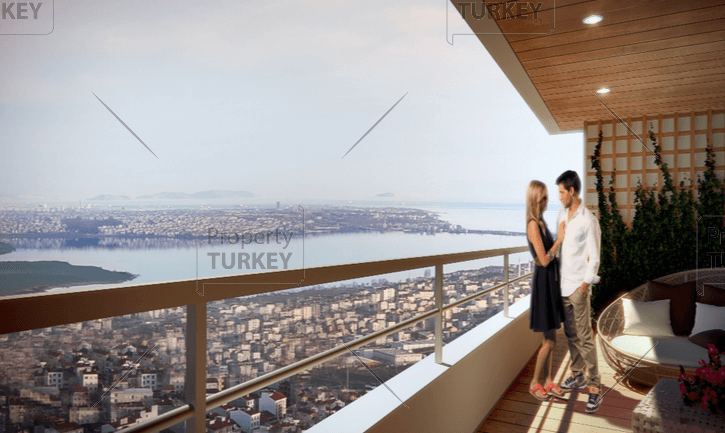As Istanbul’s population continues its rapid upward trajectory - 17 million and counting - the government is working to alleviate that most irritating aspect of city living: traffic congestion.
With the number of cars on the streets at an all time high as a growing number of commuters head into the central city each day, a number of new measures are being implemented to make travelling within the city a far more enjoyable experience.
A traffic tunnel is set to open next year, ahead of schedule after a decade of planning and construction. The 14.6-kilometre tunnel, linking Kazlicesme on the European side with Goztepe on the Anatolian side will ease traffic crossing the two large Bosporus bridges each day.
Known as the Istanbul Strait, the tunnel will allow cars to reach the opposite side in just 15 minutes, costing drivers $4.
As of this month, just 780 metres - the underwater portion - of the tunnel is awaiting completion. Engineers expect to see “first light” in August or September. When it opens, the project will have been a decade in the making.
Last year, Prime Minister Ahmet Davutoglu also announced another Bosporus tunnel project, a US$3.5 billion three-storey tunnel incorporating railway and two land routes. The 6.5km tunnel will be the first of its kind in the world, with a rail system sandwiched between two highways.

The combined road-rail bridge will have four motorway lanes and one railway line in each direction, and will convey around 300,000 cars each day.

Rail is one of the fastest and easiest ways to travel around the city, and each day well over a million people get around this way.
A number of new lines have been announced in the last few months, with others currently under construction. Within this decade the metro should serve areas as far away as Beylikduzu on the European side and Pendik on the Asian side.
The city is also introducing driverless trains, with a line being added connecting suburban Mahmutbey on the western European side, to Kabatas. The trains will travel at speeds of 90kmh and will bring Istanbul into the ranks of other large cities like London and Dubai who already utilise driverless trains.
New metro lines will connect with existing networks, allowing passengers easy transferral to bus and sea networks, and link residential and industrial areas.

There are more than 100 ferries and sea buses operating in Istanbul, some carrying as many as 2100 passengers at a time. Some popular routes have eight departures an hour. It’s estimated that the largest maritime transport corporation in the world, the Istanbul Sea Bus company, carried 47 million passengers around the city in 2014.
When it comes to ferry usage, in many ways Istanbul’s getting it right. And other large metropolitan centres - for example, New York and London - are looking to the city for ideas on how to extend their own ferry services.
Although investment in Istanbul ferries has dipped lately as the ferry system takes a hit from competing rail services, ferries are here to stay. Later this year, the Norwegian Zero Cat 120, the world’s first battery-powered, zero-emission car ferry will begin operation. So while ferries have a future, they might just look a little different - cleaner, and faster.

Speaking at a meeting over the weekend, Istanbul governor Vasip Sahin said with 600 new vehicles hitting Istanbul roads each day, authorities need to address traffic congestion in the city immediately. He has suggested imposing limits on vehicles entering the central city, citing the examples of Paris and London.
"I am not suggesting a total ban but certain measures that will discourage drivers coming in and encourage use of the mass transportation system,” he said.
“Expensive parking spaces in the city or a fee for cars entering the centre may be among the measures."

With the number of cars on the streets at an all time high as a growing number of commuters head into the central city each day, a number of new measures are being implemented to make travelling within the city a far more enjoyable experience.
Going deeper underground
Although they’re expensive to construct, tunnels connecting the European and Asian sides of the city are an effective and unobtrusive way to alleviate traffic congestion and ease the number of cars travelling over the existing Bosporus suspension bridges.A traffic tunnel is set to open next year, ahead of schedule after a decade of planning and construction. The 14.6-kilometre tunnel, linking Kazlicesme on the European side with Goztepe on the Anatolian side will ease traffic crossing the two large Bosporus bridges each day.
Known as the Istanbul Strait, the tunnel will allow cars to reach the opposite side in just 15 minutes, costing drivers $4.
As of this month, just 780 metres - the underwater portion - of the tunnel is awaiting completion. Engineers expect to see “first light” in August or September. When it opens, the project will have been a decade in the making.
Last year, Prime Minister Ahmet Davutoglu also announced another Bosporus tunnel project, a US$3.5 billion three-storey tunnel incorporating railway and two land routes. The 6.5km tunnel will be the first of its kind in the world, with a rail system sandwiched between two highways.

Bridging the Bosporus gap
A third bridge spanning the Bosporus has been in construction since 2013 and should open this year, taking a share of the traffic which is currently competing for space on the two existing bridges. The Yavuz Sultan Selim Bridge, named after the 16th century Ottoman sultan, will be 1048m long, and its towers, standing at 320m, will be the highest in the world.The combined road-rail bridge will have four motorway lanes and one railway line in each direction, and will convey around 300,000 cars each day.

Railing against congestion
A little over 10 years ago, Istanbul had just 45 kilometres of metro lines and light rail. Today, rail networks cover 150km, and there are plans to extend the system all over the city to more than 600km of rail.Rail is one of the fastest and easiest ways to travel around the city, and each day well over a million people get around this way.
A number of new lines have been announced in the last few months, with others currently under construction. Within this decade the metro should serve areas as far away as Beylikduzu on the European side and Pendik on the Asian side.
The city is also introducing driverless trains, with a line being added connecting suburban Mahmutbey on the western European side, to Kabatas. The trains will travel at speeds of 90kmh and will bring Istanbul into the ranks of other large cities like London and Dubai who already utilise driverless trains.
New metro lines will connect with existing networks, allowing passengers easy transferral to bus and sea networks, and link residential and industrial areas.

Taking to the water
Istanbul’s citizens have a long history of ferry use. Once upon a time, the only way to cross the Bosporus was by boat, and municipal ferries have been running since 1853. Each day, 300,000 commuters board the passenger boats crossing back and forth across the Bosporus. As well as being a peaceful ride, it’s often much faster than the alternatives: sitting in your car in the traffic, or fighting your way onto a crowded commuter train or bus.There are more than 100 ferries and sea buses operating in Istanbul, some carrying as many as 2100 passengers at a time. Some popular routes have eight departures an hour. It’s estimated that the largest maritime transport corporation in the world, the Istanbul Sea Bus company, carried 47 million passengers around the city in 2014.
When it comes to ferry usage, in many ways Istanbul’s getting it right. And other large metropolitan centres - for example, New York and London - are looking to the city for ideas on how to extend their own ferry services.
Although investment in Istanbul ferries has dipped lately as the ferry system takes a hit from competing rail services, ferries are here to stay. Later this year, the Norwegian Zero Cat 120, the world’s first battery-powered, zero-emission car ferry will begin operation. So while ferries have a future, they might just look a little different - cleaner, and faster.

Curbing cars to curb congestion
Istanbul’s traffic could be eased by a very simple solution: limiting the number of vehicles entering the city centre.Speaking at a meeting over the weekend, Istanbul governor Vasip Sahin said with 600 new vehicles hitting Istanbul roads each day, authorities need to address traffic congestion in the city immediately. He has suggested imposing limits on vehicles entering the central city, citing the examples of Paris and London.
"I am not suggesting a total ban but certain measures that will discourage drivers coming in and encourage use of the mass transportation system,” he said.
“Expensive parking spaces in the city or a fee for cars entering the centre may be among the measures."







